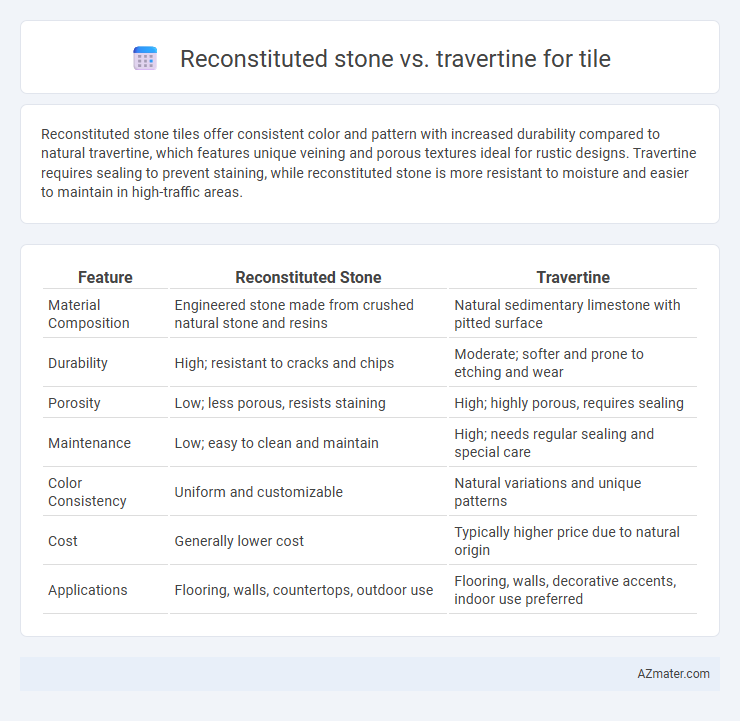Reconstituted stone tiles offer consistent color and pattern with increased durability compared to natural travertine, which features unique veining and porous textures ideal for rustic designs. Travertine requires sealing to prevent staining, while reconstituted stone is more resistant to moisture and easier to maintain in high-traffic areas.
Table of Comparison
| Feature | Reconstituted Stone | Travertine |
|---|---|---|
| Material Composition | Engineered stone made from crushed natural stone and resins | Natural sedimentary limestone with pitted surface |
| Durability | High; resistant to cracks and chips | Moderate; softer and prone to etching and wear |
| Porosity | Low; less porous, resists staining | High; highly porous, requires sealing |
| Maintenance | Low; easy to clean and maintain | High; needs regular sealing and special care |
| Color Consistency | Uniform and customizable | Natural variations and unique patterns |
| Cost | Generally lower cost | Typically higher price due to natural origin |
| Applications | Flooring, walls, countertops, outdoor use | Flooring, walls, decorative accents, indoor use preferred |
Understanding Reconstituted Stone and Travertine
Reconstituted stone is an engineered material made from crushed natural stone mixed with resins and pigments, offering consistent color and durability ideal for tile applications. Travertine is a natural limestone formed by mineral springs, characterized by its porous texture and unique vein patterns that provide a classic, timeless appeal. Understanding the differences in composition, durability, and aesthetics between reconstituted stone and travertine helps in selecting the appropriate tile material for specific design and performance needs.
Key Differences in Composition
Reconstituted stone is engineered from crushed natural stone pieces, resins, and pigments, creating a consistent and customizable material with enhanced durability. Travertine is a natural sedimentary rock formed from calcium carbonate deposits in hot springs, characterized by its porous texture and unique veining. The key difference in composition lies in reconstituted stone's controlled manufacturing process versus travertine's naturally occurring mineral structure and organic patterns.
Appearance and Aesthetic Appeal
Reconstituted stone tiles offer a consistent pattern and color, providing a modern and uniform aesthetic ideal for sleek, contemporary spaces. Travertine tiles display natural variations, with unique veining and porous textures that deliver classic, earthy appeal and add depth to traditional or rustic interiors. The choice between the two depends on the desired visual impact: reconstituted stone for precision and minimalism, travertine for organic warmth and timeless character.
Durability and Strength Comparison
Reconstituted stone offers enhanced durability and consistent strength due to its engineered composition of natural stone particles bound with resin, making it less porous and more resistant to cracking compared to traditional travertine. Travertine, a natural limestone, tends to be softer and more susceptible to chipping and wear, requiring regular sealing to maintain its structural integrity. For high-traffic tile applications, reconstituted stone delivers superior longevity and strength, reducing maintenance needs and ensuring better performance over time.
Maintenance and Cleaning Requirements
Reconstituted stone tiles require less maintenance than natural travertine due to their uniform composition and sealed surfaces that resist stains and moisture. Travertine, being a porous natural stone, demands regular sealing and gentle cleaning with pH-neutral products to prevent etching and discoloration. Routine maintenance for travertine includes avoiding acidic cleaners and frequent resealing every 1-2 years to preserve its appearance and durability.
Slip Resistance and Safety
Reconstituted stone tiles offer enhanced slip resistance due to their textured surface and customizable finishes, making them suitable for high-traffic and wet areas. Travertine tiles, while elegant with natural pores, often require sealing to improve slip safety and prevent water absorption that can increase slip hazards. Choosing reconstituted stone provides a more consistent grip and durability, reducing the risk of slips and falls compared to untreated travertine.
Cost and Affordability
Reconstituted stone tiles typically offer a more affordable option compared to natural travertine, as they are manufactured using crushed stone mixed with resins and pigments, reducing costs and allowing for uniformity. Travertine, a naturally occurring limestone, commands higher prices due to extraction, processing, and its unique, organic appearance that is difficult to replicate. For budget-conscious projects, reconstituted stone provides a cost-effective alternative without sacrificing the aesthetic appeal associated with traditional travertine tiles.
Environmental Impact and Sustainability
Reconstituted stone tiles are manufactured using natural stone fragments and resin, reducing quarrying and raw material waste compared to travertine, which is a natural sedimentary rock mined directly from quarries, often resulting in significant environmental disruption and habitat loss. The production of reconstituted stone allows for more efficient use of resources by recycling stone byproducts and minimizing extraction impact, enhancing its sustainability profile over travertine tiles, which typically require extensive processing and transportation. Furthermore, reconstituted stone can be engineered for durability and longevity, reducing the frequency of replacement and waste, whereas travertine's natural porosity and susceptibility to wear may lead to higher maintenance and shorter lifecycle, impacting overall environmental footprint.
Installation Process and Versatility
Reconstituted stone offers a more uniform and lightweight option that simplifies the installation process compared to natural travertine, which requires careful handling due to its porous and fragile nature. The consistency of reconstituted stone allows for easier cutting and fitting, reducing labor time and potential breakage. Travertine provides limited versatility in design due to natural variations, whereas reconstituted stone can be produced in a broader range of colors and patterns, enhancing customization for diverse tile applications.
Best Applications: Which Tile for Which Space?
Reconstituted stone tiles offer superior durability and consistent color, making them ideal for high-traffic commercial spaces such as shopping malls and office lobbies. Travertine tiles, prized for their natural veining and porous texture, suit residential applications like bathrooms and kitchens where aesthetic appeal and slip resistance are essential. For outdoor patios and pool surrounds, travertine's weather-resistant qualities perform well, whereas reconstituted stone excels in areas requiring uniformity and easy maintenance.

Infographic: Reconstituted stone vs Travertine for Tile
 azmater.com
azmater.com